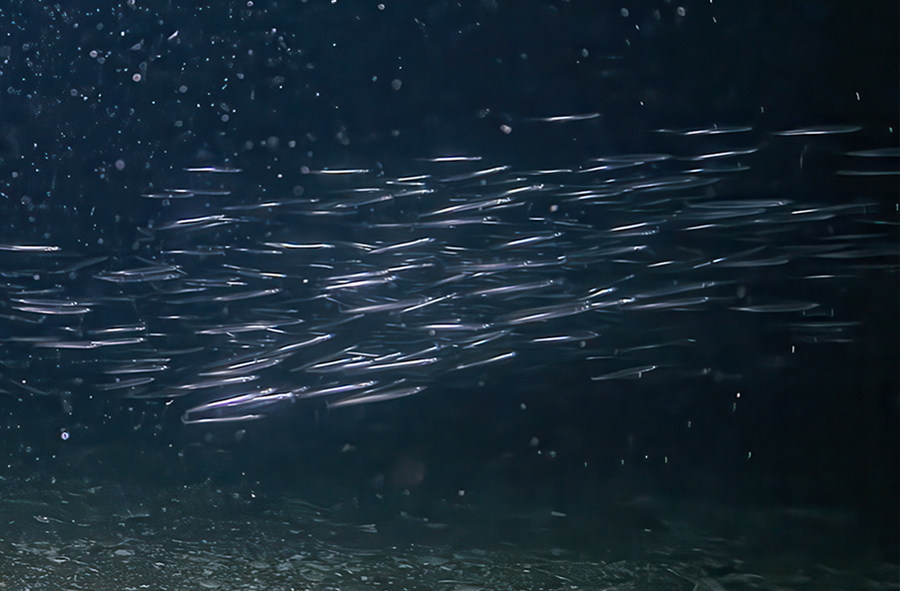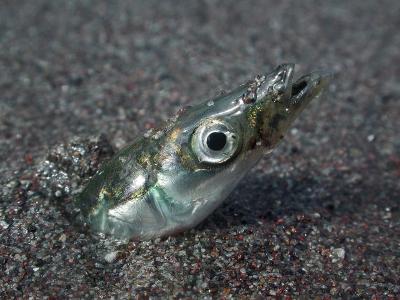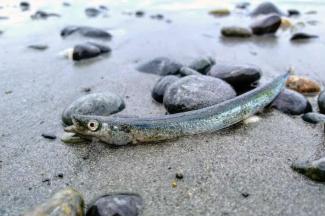
Distribution:
Commonly found in the temperate and subarctic regions of the
Northern Hemisphere. They are distributed across the North Atlantic
and North Pacific Oceans, including the coasts of North America,
Europe, and Asia. They are known to inhabit shallow coastal waters
and sandy substrates.
Ecosystem:
Typically found in coastal and shelf ecosystems. They
prefer sandy or gravelly substrates where they can bury themselves.
These fish play a critical role in the marine food web, serving as a key
prey species for many larger fish, seabirds, and marine mammals.
Feeding Habits:
Primarily feeds on zooplankton, including copepods and other small
crustaceans. They are also known to consume fish larvae and eggs.
Their feeding habits make them an essential link between planktonic
organisms and higher trophic levels in marine ecosystems.
Taxonomy:
Class: Actinopterygii
Family: Ammodytidae
Species: Ammodytes spp.
Distribution
The sand lance, also known as the sand eel, is a type of small fish found in oceans worldwide. They primarily inhabit temperate and cold waters in the Northern Hemisphere but also can be found in similar waters in the Southern Hemisphere. From Arctic coastal waters to sandy tropical sea bottoms, sand lances are adaptable to many different environments and are a ubiquitous presence in marine ecosystems.
Ecosystem
A vital part of marine ecosystems, the sand lance serves as a prey species for many larger predators. A slender fish with a skinny snout, they are a favorite food of humpback whales, sharks, seals, sea birds and many fishes. Their abundance and distribution are a crucial sign of coastal food webs, and their role as a forage fish makes them essential in the energy transfer within their ecosystems, a critical link to larger creatures at higher trophic levels.
Feeding Habits
The sand lance primarily feeds on zoo plankton and small crustaceans. As filter-feeders they utilize a specialized gill structure to strain tiny prey from the water column. This feeding behavior is efficiently adapted to exploit the rich planktonic resources in the coastal waters they inhabit, which allows sand lances to thrive in various marine environments. By consuming the energy and nutrients of plankton, some of the smallest organisms in their ecosystem, sand lance provide a means to transfer this energy to the larger organisms that consume them.
Overview and Physical Characteristics
With elongated, slender bodies and pointed snouts, sand lance range from 8 to 18 inches (20 to 46 centimeters) in size. Their various colors and patterns allow them to easily blend into their sandy surroundings for camouflage. When they are not searching for plankton to eat, the sand lance remains close to the seabed, hiding from predators. (They know they are delicious!)
Habitat and Distribution
Predominantly found in shallow coastal waters, sand lance prefer to inhabit sand or gravelly substrates where they can burrow for protection. Depending on the species and environmental conditions, sea lance can live in waters from shallow intertidal zones to depths of up to 330 feet (100 meters). This preference for a certain habitat makes sand lance quite vulnerable to climate change. If warming waters move plankton blooms to a different habitat, the potential for the sand lance to go hungry is very real, which could have very real impacts further up the food web as well.
Behavior and Reproduction
During the day the sand lance feeds in the open water, burrowing into the sand at night to avoid predators. Sand lance travel in large schools that provide safety in numbers from predators. When sand lance are attacked by diving seabirds, they engage in “balling” behavior, swimming in a tight swirling circular pattern to reduce the chance of an individual sand lance being eaten. Unfortunately, these large aggregations of sand lances are then vulnerable to attacks by seals, sea lions, and other marine mammals. Scientists do not know how sand lance breed, but they do know that the fish release fertilized eggs into the water column, where they incubate for about four weeks before turning into tiny larval sand lance, which then survive into adulthood by living among floating plankton.
Fun Fact
True to its name, the sand lance is known for burrowing face-first into sandy substrates to escape from predators and adverse environmental conditions. These burrows can extend several inches into the sediment, providing the sand lance a place to hide from the variety of birds, fish, and mammals that want to eat them.
Sand Lance and BOEM
To better understand the potential impacts sand harvesting could have on the sand lance – and the fish, birds, whales and seals that depend on them – BOEM partnered with the Stellwagen Bank National Marine Sanctuary located offshore of Massachusetts. No mining or leasing activities are permitted in the Sanctuary, making it an ideal living laboratory to better understand sand lance populations and seafloor ecology.
This story is part of the “Unleashing the Science” series, showcasing how bureaus within the Department of the Interior produce and apply science to ensure responsible management decisions for our planet now and for the future.
--BOEM--
The Department of the Interior’s Bureau of Ocean Energy Management (BOEM) manages development of U.S. Outer Continental Shelf (OCS) energy, mineral, and geological resources in an environmentally and economically responsible way.



